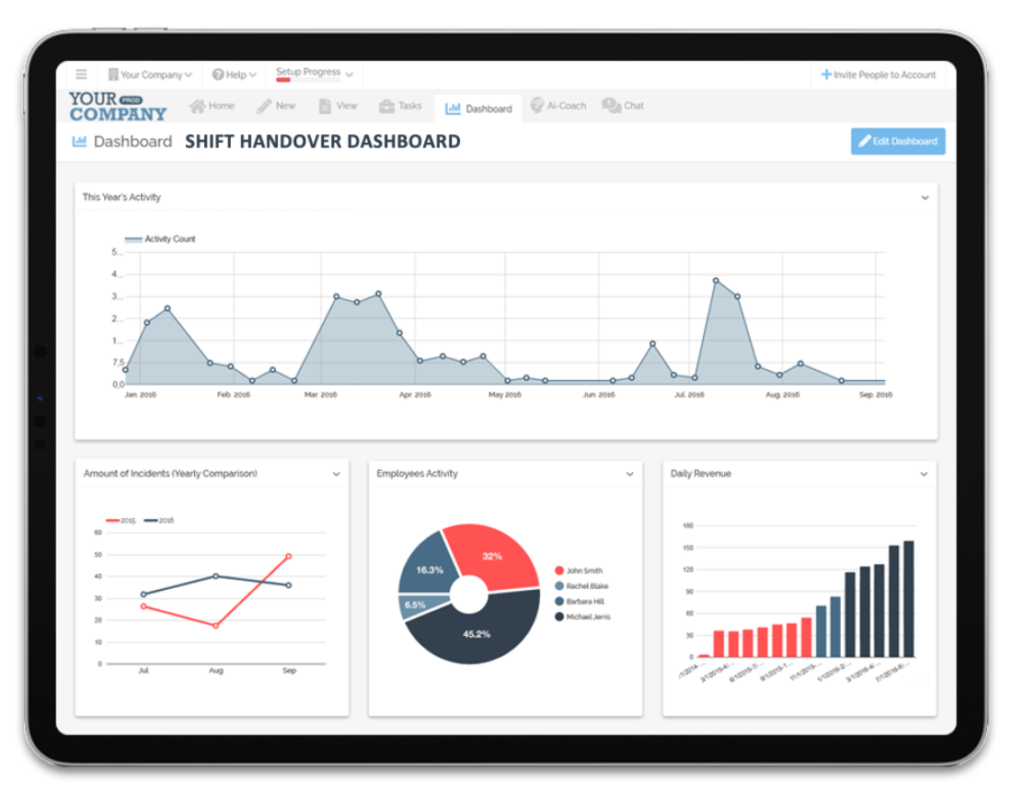Efficiency in any operational environment heavily relies on the seamless transition between work shifts. Shift handover SOPs are integral to ensuring a seamless transition between shifts, enabling the continuity of operations and maintaining productivity.
This guide delves deeper into the significance of the shift handover process, focusing on creating Standard Operating Procedures (SOPs), outlining essential steps for SOP creation, and offering best practices for ensuring a smooth handover process.
Importance of Structured Handover Procedures

A structured shift handover process is important for two main reasons:
- Continuity
- Streamlining communication
Ensuring Continuity and Operational Efficiency
Structured shift handover procedures play a pivotal role in ensuring a smooth transition between different work shifts.
They facilitate the transfer of critical information, pending tasks, ongoing issues, and essential updates, enabling the incoming shift to seamlessly pick up where the outgoing one left off.
Mitigating Errors and Miscommunication
A well-structured handover process significantly reduces the chances of miscommunication, errors, and omissions that may occur during shift transitions. It ensures that the incoming team is equipped with the necessary information to carry out their responsibilities effectively.
Elements of an Effective Shift Handover SOP
A well-structured shift handover sop should have the following characteristics:
Clear Documentation of Tasks and Responsibilities
Clear and concise documentation detailing tasks, responsibilities, ongoing issues, and pending assignments is essential for a successful handover. This information should include specifics on deadlines, priority tasks, and any issues that require immediate attention.
Effective Communication Protocols
Establishing robust communication protocols is critical. This includes choosing appropriate communication channels, such as in-person meetings, digital platforms, or shift handover books, to ensure seamless information transfer.
4 Stages of a Seamless Shift Handover Procedure

When creating an SOP for shift handovers, several crucial steps need consideration. First, identification of key stakeholders and their roles is essential. Defining who is responsible for what and outlining communication channels and reporting methods fosters clarity during transitions.
Additionally, the SOP should emphasize the importance of information accuracy, the use of standardized forms, and the need for regular updates or reviews to adapt to changing operational needs. A well-crafted SOP ensures a structured and efficient handover process.
Step 1. Preparation
Ensure all necessary documentation and information is up-to-date and readily accessible.
Review pending tasks, ongoing issues, and critical updates to be communicated.
Step 2. Initiate Handover
The outgoing team initiates a meeting or communication session with the incoming team.
Essential information, including pending tasks, critical updates, and ongoing issues, is communicated.
Step 3. Information Transfer
Clear, precise, and comprehensive information transfer is executed to ensure that the incoming team is well-informed.
Utilize documentation, digital platforms, or other specified tools for this transfer.
Step 4. Confirmation and Acknowledgment
The incoming team acknowledges the information received and seeks clarification on any uncertainties.
Both teams ensure a mutual understanding of the handover details.
Advantages of Implementing Shift Handover SOPs
Implementing shift handover SOPs enhances productivity, improves collaboration, and reduces errors and risks. Let’s look at these advantages in more detail below:
Enhanced Productivity
By minimizing the loss of critical information, an effective handover process enhances productivity, ensuring smoother transition between shifts.
Improved Team Collaboration
A well-structured handover procedure fosters better collaboration and understanding among team members, leading to increased efficiency and reduced errors.
Implementing Shift Handover With FAT FINGER

FAT FINGER, a cutting-edge solution in shift handovers, revolutionizes this exchange by offering a user-friendly, digitized platform. Its intuitive interface enables efficient transfer of information, significantly reducing the margin for error that often accompanies manual processes.
Advantages of Implementing Shift Handovers with FAT FINGER
- Enhanced Accuracy: By digitizing the handover process, FAT FINGER minimizes human errors, ensuring that vital data is accurately transferred.
- Real-Time Updates: This technology facilitates real-time communication, enabling immediate updates and alerts for critical information.
- Streamlined Operations: The streamlined interface of FAT FINGER enhances the overall efficiency of the shift handover process, promoting quicker decision-making and task allocation.
FAT FINGER Features
Do you want to transition from one shift to another efficiently? Sign up for FAT FINGER and get access to:
- Drag and drop workflow builder
- Mobile and desktop workflows
- Powerful reports and dashboards
- Artificial Intelligence coaching
- Augmented reality
- Ability to connect to IoT devices




